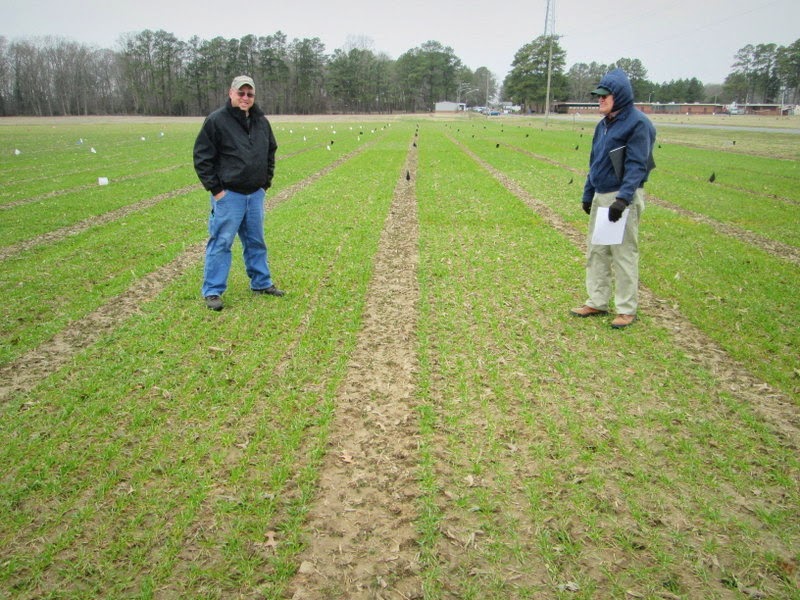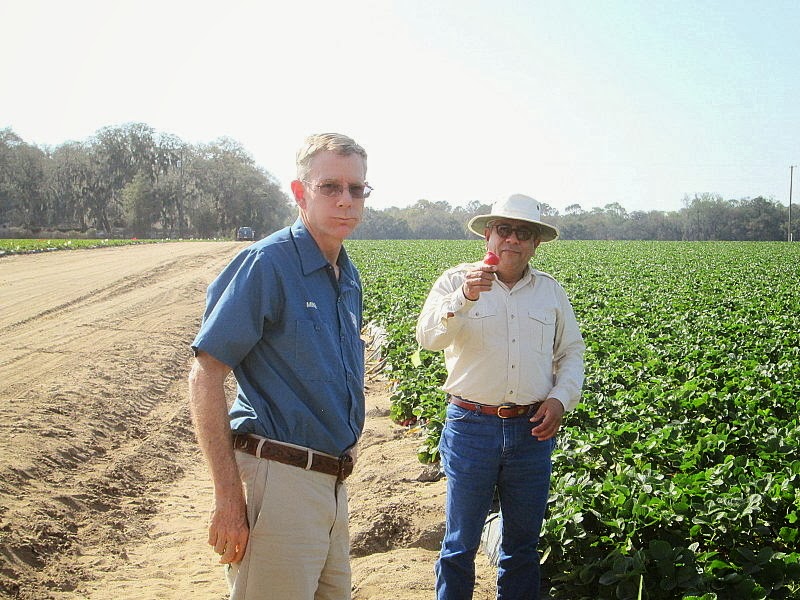So last week I made my way to Raleigh, North Carolina where I was met by SAM Ashley. This was my first on-the-job visit to North Carolina. Ashley has only been there less than a year. Anyway, we had several tasks to complete over the next few days. One of those was to meet with some researchers in North and South Carolina about conducting some fertilizer plot work. But on our way to Southern South Carolina, there was a sign for the South Carolina Cotton Museum in Bishopville. Well you know me and interesting sounding roadside attractions. So we took the exit and found our way to the museum. And it was well worth the price of admission. Here we see Ashley all excited to begin the tour.

It showed some of the old time tools of cotton production. Like this tool for application of guano called the Guano Sower. What's guano you ask? Well it's bird and bat droppings. And I don't mean feathers. In this case it was mostly sea gull droppings according to the description. Now I don't know who had the job of following sea gulls around with a bucket to get the supply of guano. But that would certainly be an inspiration to do well in skool. Not sure if farmers used to go to meetings where guano sales and research reps would try to get growers to use their brand. How far we've come. (Or have we?)

And here is a fertilizer grinder. I think this was in the post-guano period in 1920. But the sign says it was for "soda, acid and kainite". What's kainite you ask? Well it's a blend of potassium chloride (potash?) and magnesium sulfate (epsom salts?). It has a handle on the side to grind it up. Hope it worked. But this was in the period when fertilizers were gaining more use. Before, cotton was not fertilized at all and people wondered why it didn't yield well after a couple of years.

And everyone has probably heard of the boll weevil. It was the number one pest of cotton for many years. Anyway, below is the Cotton Mopper. It was used back in the 1930's and the cloth was coated with molasses and some sort of weevil poison and would spin as you walked along to coat the flowers with the stuff to kill the weevils. It was sticky and dirty work. But was the best way to control the pest at the time. Evidently they used to really use mops before this tool came along. In fact, I read a little of the "mopping" history, and evidently no one liked doing it. You got covered in molasses and flies. They used to make kids do it, since the adults didn't want to. There is reference to former president Jimmy Carter mopping cotton as a kid in Georgia. He would stand his pants in the corner at night since they were so stiff from the molasses.

Here is a boll weevil model. I didn't know they were so big. No wonder they were so hard to control. But now thanks to Bt cotton, the cotton plant can defend itself and it is no longer necessary to spray multiple treatments of insecticides. Or to mop either. Thank goodness for GMO technology to increase cotton production while protecting the environment.
They had lot's of old machines that turned the cotton fiber into thread.
There was plenty to see and it was well worth the stop. I give it a hearty thumbs up.
After meeting with several researchers about test plots on crops like cotton, soybeans and tobacco, we proceeded to the other activity for the fertilizer mission. That being a grower meeting at our AM in Eastern NC: Dark Water Enterprises of Pantego, NC. They have been selling Liquid fertilizer for several years in this part of North Carolina. It is run by the Boyd Family and they have done a great job in a relatively short time. There is a lot of good farmland around here, large and flat fields growing corn, soybeans, cotton and some tobacco, sweet potatoes and other crops. It was my first time here.
Need some Liquid fertilizer? They can certainly provide...and deliver as well. That's just one of several tanker trucks on the premises.
Ashley started the meeting with an interesting lead in on AgroLiquid history and products. But she made the connection and tied it all together very well.

The farmland in this area has an interesting history that I was not aware of. It seems that much of this area was covered with cedar swamp. But in the early 1970's a Wall Street millionaire ended up buying 325,000 acres of this ground and set about clearing it for farmland, starting in 1973. Specifically, it is in the Albemarle-Pamlico Peninsula, if anyone wants to know the exact location. He called the operation First Colony Farms, and had the goal of establishining a sustainable crop and livestock operation once the ground was cleared. Well there was so much trees and swamp, that drainage ditches were also built and the cleared trees were put in piled strips. Some of the land had many feet of peat and tree residue, so another operation was started to harvest the peat for an energy source. But as with many gigantic ventures, it never came to be and the investor saw his millions dwindle away into bankruptcy. Kind of like the joke: "How do you become a millionaire in farming? Start with ten million." It was re-bought a few times and the most of the land was in fact cleared and is farmed today. But not as a super farm. I'm not sure where the boundaries are of this venture, but somewhere around where we were. But most of the land was at one time covered with swamp and cedar forest. We talked to a researcher near Dark Water, and the ground is generally high organic matter. Plus it is high in P and K from chicken litter, a common application. Below is one of the fields where we may have some plots this summer.

It was cold and rainy most of the week. On the way back to Raleigh, we passed a piece of ground that was evidently being cleared. So this is what it might have looked like back in the 1970's when it was being cleared. Except there are no bulldozers seen here in the winter. It is definatily dark organic ground.
So now there are some large individual farming operations in place, and it is our goal to have AgroLiquid feeding the crops there. There was a lot of interest after our stellar grower meeting. At least I thought it was.












































